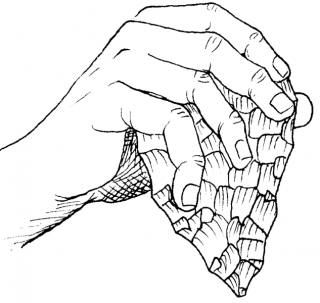Genetics
Making a Monkey Out of Early Peopling of the Americas
What will it take to recognize the oldest traces of humans in the Americas?
Posted March 29, 2014
The New York Times published a story on March 27 headlined Discoveries Challenge Beliefs on Humans’ Arrival in the Americas. Written by Simon Romero, it is also titled a "Serra Da Capivara National Park Journal", and leads with images of fabulous rock paintings in the park attributed dates of 9000 years ago.
The controversy reported is not actually particularly new.
South American scientists, and scientists working in South America, have been arguing for decades that many sites in that continent have evidence of human occupation dating earlier than the generally accepted dates for North America's Clovis tradition, understood to have started around 13,000 years ago, and asserted to be the original peopling of the Americas.
An interview-format article from 2002 summarized then-current interpretation of the key site, Pedra Furada (located in the same park as the newly reported site, Toca de Tira Peia) by the international research team of Brazilian and French scientists, who have never backed off their proposal that evidence of human occupation dates to at least 48,000 years ago.
The specific scientific paper that the Times cited in its recent column was actually published in June of 2013, and had been discussed in the popular science press as early as April 2013.
There doesn't seem to be anything more recent to make the story newsworthy. But the Times story raises interesting questions about what it takes to displace dominant models: not just evidence, but also assumptions have to change.
The basic dispute goes like this: if the Americas were peopled by groups moving exclusively across a "land bridge" that opened up linking Alaska and Siberia, then the only opportunities for humans to reach the Americas from Asia would be correlated with glacial episodes when that land bridge existed. Clovis style stone tools are found in sites in North America consistent with one of these episodes, and so that relatively late date of 13,000 is the initial peopling of the Americas.
But in fact, geologically, the land bridge is understood to have formed and stayed open from about 25,000 to 10,000 years ago, so there is nothing to say that there couldn't have been earlier populations moving across it.
Hints of these earlier people-- awkwardly called "pre-Clovis"-- are known from sites throughout the Americas. One Chilean site, Monte Verde, was finally, after years of debate, accepted by North American scholars as having clear evidence of human occupation at around 12,500 years ago.
What the pre-Clovis sites that have been accepted demonstrate is that people were established across North America and far into South America by the time the Clovis tradition started. But how much earlier were these people on the scene?
The new research reported last year-- published in the Journal of Archaeological Science, a very sober peer-reviewed source, and thus normally to be taken as accepted fact-- met with some serious skepticism, because the authors argued that people were living inside the modern limits of Brazil 10,000 years earlier than the begrudgingly accepted pre-Clovis sites.
The relatively new technique used to obtain dates for Toca de Tira Peia, optically stimulated luminescence (OSL), has not been the center of objections, which might be the expected basis of criticism.
Instead, what has formed the focus of controversy is whether chipped stones excavated at the site actually were products of human actions: tools that point to the presence of human makers.

hand axe by José-Manuel Benito Álvarez
One skeptic was quoted as saying the stone objects reported could have been stones that broke naturally.
Another critic, tacitly accepting that the chipped stones have features unlikely to have formed through simple geological processes, still managed to resist their interpretation as products of an early human population, suggesting that a "possibility is that capuchins or other monkeys produced the tools".
The resistance to acknowledging at the very least that this is a site where human beings lived led a frustrated proponent of early sites in South America, Vanderbilt University's Tom Dillehay, excavator of the Monte Verde site, to say that this skeptic "does not know what he is talking about...To say monkeys produced the tools is stupid.”
I don't know if skeptics of early human presence in South America are smart or not: but they surely are stubborn, if they are more willing to suggest that the chipped stone tools published from Toca de Tira Peia were more likely made by monkeys than by early human residents, than to accept the possibility that human beings were responsible for this assemblage.
This is not to deny observations of capuchin monkeys using stones as tools to smash food items. But the reported stone tools illustrated in the Journal of Archaeological Science include retouch: signs that someone refined the edge, or renewed it after use. I have found nothing to suggest that New World monkeys are engaged in this level of technical refinement of the stones they pick up, use, and drop.
Stubborn also seems to be a reasonable word to apply to the second argument made by the same skeptic in the New York Times piece. There, this critic is cited as saying that
the Clovis model was recently bolstered by new DNA analysis ancestrally connecting indigenous peoples in Central and South America to a boy from the Clovis culture whose 12,700-year-old remains were found in 1968 at a site in Montana.
The reporter for the Times quotes Michael R. Waters of Texas A&M suggesting that genetic relationships established between living Central and South American Indians and the ancient boy whose remains were recovered in Montana don't actually settle things so clearly. Allowing the possibility that there was an earlier population in Brazil, not descended from Clovis people, Dr. Waters said
“If so, then whoever lived there never passed on their genetic material to living populations...We must think long and hard about these early sites and how they fit into the picture of the peopling of the Americas.”
In fact, the study of the Montana boy-- called the "Anzick child" by researchers-- isn't actually primarily concerned with proving that the Clovis population was the first in the Americas. It was aimed instead at resolving other recent proposals that suggested that Clovis people were not related to living Native Americans. The most widely reported suggestions of this sort had proposed that Clovis people might have been immigrants from Europe, displaced by later immigrants ancestral to living Native Americans.
Trying to use the Clovis child as evidence for a short history of people in the Americas directlty contradicts the explanation proposed by the research team that was able to sequence the DNA of this individual, buried 12,700 years ago. They concluded that
the most likely scenario is that an ancestral population that lived several thousand years before the Clovis period split into two groups, one staying north and one going south. Just where and when this split happened cannot be determined from the genetic data.
"An ancestral population that lived several thousand years before the Clovis period split into two groups, one staying north and one going south".
Asked by an interviewer in 2002 to explain why there was resistance to the antiquity proposed for Brazilian sites, archaeologist Niède Guidon replied
I cannot understand why. Perhaps because when you are the first to discover something, people want to kill you because you disturbed the placid waters of the lake... in prehistory it is not possible to say that something does not exist only because we do not find them. A theory is not a law, but may and must be changed each time new facts are discovered.
Another member of the research team, Fabio Parenti, answered the same question somewhat more diplomatically, but also indicated that personalities might underlie some of the skepticism, saying it could be traced to three reasons
a) lack of detailed publications; b) the very peculiarity of such old dates, with poor “undisputable” evidence; c) lack of direct participation in the field effort of an international team (isolation of Brazilian archaeologists).
In an ideal world, models wouldn't exercise such a grip over people that they reached for seemingly unlikely explanations, rather than consider the more obvious one; or that they would ignore the way data were interpreted to contradict their position, and cite the same findings in support of something explicitly undermined by the original research team.
Not stupidity, but stubbornness, seems to be in question here: and like many specialists working in Latin America, I cannot escape an uneasy sense that the main reason for such strong continued skepticism is that the work is being done by people from another academic tradition, who speak a different language and whose findings, if they hold up, suggest that our best evidence of early human presence in the Americas is to be found far south, not in the places that North American archaeologists have so long insisted held the keys to the story.




